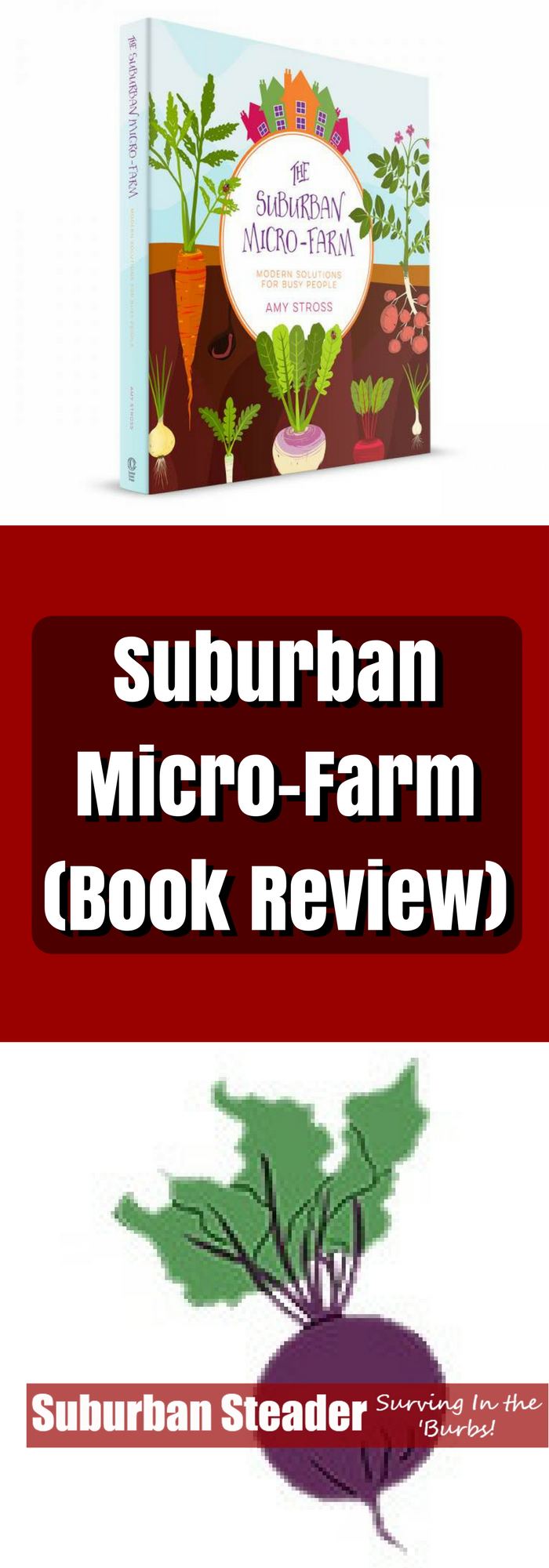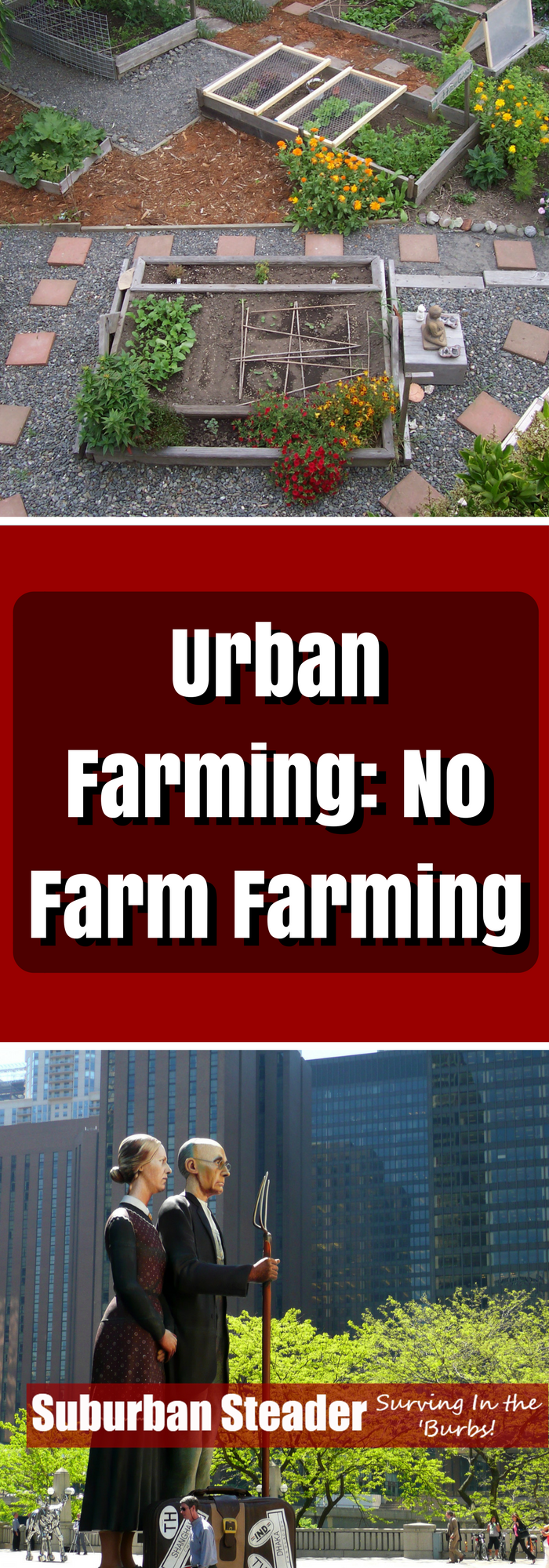Suburban Micro-Farm (Book Review)
What is the first thing that a suburban homesteader does? I’m sure you guessed correctly – they start a garden. It’s probably the easiest thing to do to start a self-reliant lifestyle because of many reasons. There’s a low barrier to entry – you just need some dirt and a few seeds – and it’s also more socially acceptable than storing large quantities of food, water and/or ammunition. Amy Stross of TenthAcreFarm.com fame has realized this fact. She also knows that starting a micro-farm on her suburban plot has started her walk to self-reliance. She’s taken all she’s learned during her years of micro-farming (read: large-scale gardening) and put it together in one of the most well-written, easy to read books on the topic that I’ve ever read. Read on to find out why you need The Suburban Micro-Farm in your suburban homesteading library today!
Book Set-Up
Amy put her heart and soul into this book and it’s quite obvious. She takes a very intelligent approach to the layout of the book. It is broken down into three parts – Getting To Know the Micro-Farm, Becoming A Micro-Farmer and Advanced Micro-Farming Techniques. Each part has sub-chapters and each chapter has subsections. This intensive breakdown allows you to use this book as a reference book and quickly get to the area that you need immediate information on.
Likewise, the book is written in such a way that you can read it from beginning to end (I did) and build upon the sections you’ve already read.
The parts and chapters of this book are as follows:
Introduction
The Introduction is just that – an introduction to the book and a general layout of what Amy plans on teaching us and how the book is laid out.
Part I – Getting To Know The Micro-Farm
Chapter 1 – Suburbia: Civilization’s Opportunity
This chapter consists of the following parts:
- The Suburban Problem
- Suburban Micro-Farming Myths
- The Suburban Micro-Farm Solution
Chapter 1 is a very interesting chapter because you get to hear a lot about Amy’s journey through suburban gardening to suburban farming. You hear – at a high level – about some of her pitfalls and the errors she made. You also get to explore some of the myths associated with farming/gardening in the suburbs and what the truth really is.
Chapter 2 – Managing Expectations
This chapter consists of the following parts:
- Prevent Garden Overwhelm Syndrome
- Life Hacks for the Busy Micro-Farmer
- When It’s Not Enough
- Overcoming Brown Thumbs
- Setting Up Your Neighborhood for Success
Many suburban gardeners and farmers are discouraged when they don’t have immediate success. Amy walks you through some life hacks to see better results early and get a few quick wins. You’ll build on these wins and get comfortable as a suburban farmer. The biggest tip I took out of this section was to spend fifteen minutes every day (every.single.day) in the garden. This approach will make sure that you see what’s going on and don’t let things go too far and become a bigger problem.
Chapter 3: Developing Healthy Soil
This chapter consists of the following parts:
- Building Soil Health and Fertility
- Guide to Organic Soil Amendments
- No-Till Micro-Farming
- Constructing a Simple Compost System
- How to Compost
- Cultivate Worm Castings with Vermicomposting
Soil is the lifeblood of a great suburban micro-farm. This chapter of The Suburban Micro-Farm is great because it walks you through all the different ways to build high-quality soil. These approaches will create a great base layer for your crops and allow you to achieve success earlier.
Chapter 4: Vegetables On The Farm
This chapter consists of the following parts:
- The Efficient Micro-Farm
- Guide to Planting and Growing Vegetables
- Choosing Crops to Meet Your Needs
- How to Place Vegetables
- Extending the Season with Cold Frames
Soil is great, but folks plant gardens and farms to get produce. This chapter is chock full of information on many different crops you can grow. It tells you how to grow them, what crops to grow with them to promote successful harvest and how to rotate your crops annually.
Chapter 5: Micro-Farming Fruit
This chapter consists of the following parts:
- Growing Fruit Trees
- Growing Berries for Beginners
- Choosing Fruit for Your Circumstances
So, you’ve got your vegetables squared away, right? What about fruit? Fruit is sometimes easier for the suburban micro-farmer because it is typically an annual product. You only plant it once and receive output (harvest) every year after that. This chapter is a goldmine of information on where to plant certain fruit, how to harvest it and when to harvest it. This chapter has really prompted me to plant currants and grapes in my yard.
Chapter 6: Growing Herbs On The Micro-Farm
This chapter consists of the following parts:
- Kitchen Garden Herbs
- Herbs in a Pollinator Garden
- Create an Herb Spiral
If you like to cook then you know how important herbs are to making that special dish really pop. Herbs are also instrumental in medicinal settings (see Cat Ellis’s book Prepper’s Natural Medicine). And, on top of those things, they also attract pollinators to your crops. This chapter provides great guidelines for planting herbs and designing your suburban micro-farm in a way that utilizes your herbs for many different factors.
Part II – Becoming A Micro-Farmer
Chapter 7: Organizing Your Micro-Farm
This chapter consists of the following parts:
- Make a Garden Sketch
- Make Seed and Supply Purchases
- Month-by-Month Micro-Farming
- Checklists and Monthly Calendars
Good farmers are organized farmers. Amy has spent a lot of time putting together a companion website to this book (you’ll have to buy the book to find the website address). The resources on this website help you plan and track the performance of your garden. I’ve already dug into these and plan on using them this summer.
Chapter 8: Seed Starting & Planning
This chapter consists of the following parts:
- Starting Seeds Indoors: A Step-by-Step Guide
- How to Sow Seeds Directly Outdoors
- How to Transplant Seedlings Outdoors
Seed starting isn’t always as simple as it sounds. Amy does a great job of explaining seed starting in this chapter of The Suburban Micro-Farm. She also talks heavily about transplanting and the – to me – always nebulous task of hardening off transplants.
Chapter 9: Maintaining The Garden & Harvesting The Produce
This chapter consists of the following parts:
- Daily Garden Visits
- Mulching in the Garden
- Watering
- Pest Management
- Guide to Harvesting Vegetables
- Cleaning up the Garden for Fall
- Easy Seeds to Save
- Storing Seeds
You’ve set up your garden, started your seeds and transplanted them successfully to the garden. Now, what do you do? Mulching, water, pest management and harvesting are all tasks that help promote suburban micro-farm success. Amy spends a good amount of time talking about all of these tasks and also delves into seed saving. Seed saving is SO important because you can capture seeds from produce that survived in your area and slowly build a seed base for plants that will be more successful in your location.
Part III – Advanced Micro-Farming Techniques
Chapter 10: Edible Landscaping
This chapter consists of the following parts:
- Why Landscape with Edibles?
- Things to Consider before Breaking Ground
- Landscape Design Principles for Visual Appeal
- Planning Techniques for the Edible Landscape
- Choosing What to Plant
- Utilizing the Parking Strip
Amy has taken the next step with her micro-farming and moved onto an edible landscape. She’s slowly removing the useless lawn on her property and replacing it with plants that are not only beautiful but functional. Learn how she’s doing it in this chapter!
Chapter 11: Digging Deeper: Permaculture & Micro-Farming
This chapter consists of the following parts:
- Using Water Wisely
- Building Plant Guilds
- Farming the Contour
- Terracing with Check Logs
- Managing the Edges
- Permaculture Plants
Interested in permaculture? This chapter is, by far, the longest in the book. It’s also the most information-dense chapter. Amy basically compressed an entire Permaculture Design Course (PDC) into one chapter. I absolutely loved this chapter because it’s not only permaculture-centric but it is permaculture-centric to the suburban homeowner mindset. I would often struggle to see how approaches learned in a PDC could be utilized in a suburban setting. Amy helps guide us in that direction.
Chapter 12: Making Money On The Suburban Micro-Farm
This chapter consists of the following parts:
- Perennial Crops
- Annual Crops with a Long Season
- Shade Crops
- The Edible Plant Nursery
- Cut Flowers
- Maple Syrup
- Cottage Food Products
- Homemade Soap
- Teaching and Writing
- Tips for Success
If you follow all the tips, trick and techniques in of The Suburban Micro-Farm, you’ll most likely have more produce than you and your family can handle. Why not make some money off of it? Amy walks us through ways to monetize your suburban micro-farm. Genius ideas here. Worth the price of the book in and of itself.
Conclusion
Amy ties it all up in the conclusion. She has additional sections such as Acknowledgements, Bibliography, and Additional Resources (Books and Online). These sections are incredible as well and allow the reader to continue their self-education in a variety of different places.
Why I Liked The Suburban Micro-Farm
There are a lot of things I liked about this book. But, most importantly, I think the fact that it’s a hands-on book is what I like most. All the information here is not theoretical but, rather, it’s proven tactics with suggestions on how to implement them yourselves. Tactics and strategy in the same book. Incredible.
Amy’s companion websites and resources – there are at least four Google spreadsheets she’s set up for you – are just incredible. She could probably sell these as a kit themselves but they are “free” with a purchase of the book.
Finally, I liked the layout of the book. It grows the reader’s knowledge if read chronologically but also allows for pinpoint referencing of information. Great approach Amy!
What I Didn’t Like
I hate saying that there’s nothing I didn’t like about a book but there isn’t anything I don’t like about this book. I think it’s great! In the first edition, the one thing I didn’t like was was the printing. The first edition was printed in black and white and it was quite obvious that the master copy was in color. The black and white printing did all the pictures and colored text injustice.
Amy fixed this issues in the second edition and I have to say that it made an already great book incredible! Even if you picked up the first edition, I would suggest getting the second edition. The addition of color to this printing is just amazing!
Overall Thoughts on The Suburban Micro-Farm
Point blank, this book is a must-have for any suburban homesteader who is even thinking about growing fruit, vegetables or herbs on their land. Amy Stross underestimates her ability to convey complex information in a simple, straight-forward manner. Likewise, she has done a great job of putting together a book that is both awesome in its long form as it is a pinpoint resource book.
It is very, very rare that I state emphatically that a book is required for your suburban homesteading library. This book goes alongside Cat Ellis’s Prepper’s Natural Medicine and Anna Hess’ The Weekend Homesteader as MUST HAVES in your library!

Disclaimer: Amy Stross supplied a copy of The Suburban Micro-Farm for me to review. I can assure my readers that I gave it a fair and honest review.
